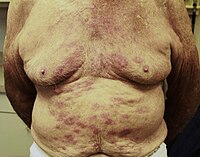
Photo from wikipedia
The emergence of SARS-CoV-2 and the subsequent pandemic has highlighted the need for animal models that faithfully replicate the salient features of COVID-19 disease in humans. These models are necessary… Click to show full abstract
The emergence of SARS-CoV-2 and the subsequent pandemic has highlighted the need for animal models that faithfully replicate the salient features of COVID-19 disease in humans. These models are necessary for the rapid selection, testing, and evaluation of potential medical countermeasures. Here, we performed a direct comparison of two distinct routes of SARS-CoV-2 exposure—combined intratracheal/intranasal and small particle aerosol—in two nonhuman primate species, rhesus and cynomolgus macaques. While all four experimental groups displayed very few outward clinical signs, evidence of mild to moderate respiratory disease was present on radiographs and at necropsy. Cynomolgus macaques exposed via the aerosol route also developed the most consistent fever responses and had the most severe respiratory disease and pathology. This study demonstrates that while all four models produced suitable representations of mild COVID-like illness, aerosol exposure of cynomolgus macaques to SARS-CoV-2 produced the most severe disease, which may provide additional clinical endpoints for evaluating therapeutics and vaccines.
Journal Title: Viruses
Year Published: 2022
Link to full text (if available)
Share on Social Media: Sign Up to like & get
recommendations!